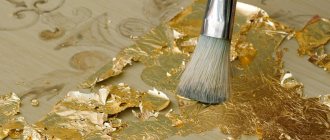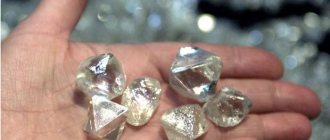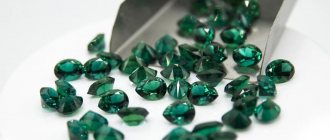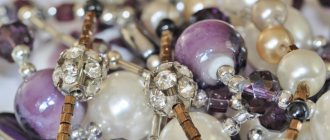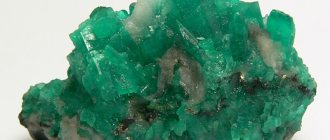Good afternoon, dear readers! Surely many of you have noticed that silver jewelry with natural stones has become especially popular lately. They can look different: some are very simple, while others are very impressive.
The metals are visually similar - white gold and platinum: what is the difference between them and what causes the significant difference in price? I propose to look into this issue.
What is platinum and white gold
Platinum is a naturally occurring precious metal with a silvery-white color. It has been known to mankind for more than 4 thousand years, but has been used in jewelry relatively recently. It is widely used in technical production, medicine and high technology. In the periodic table it is designated as Pt; its reserves on the planet are limited.
White gold is always an alloy where the main component is gold (Au), and metals are used as alloys that give it a white color. To ensure that the surface of the product has a noble silver-white hue, it is coated with rhodium. It not only protects against scratches, but also preserves color.
What is white gold?
Essentially, it is an alloy of yellow gold with other metals and chemical elements - an alloy. It is this that determines the final shade and physical qualities of the product. The most suitable elements are selected for different types. For example, nickel is commonly added to gold rings and earrings to make them more durable. In addition, the ligature may include:
- bronze;
- platinum;
- zinc;
- palladium;
- silver.
The presence of specific components and their concentration also affect the cost of jewelry or other white gold items. Nickel and silver are mixed into budget products, and palladium and platinum are added to expensive ones. Before purchasing, it is advisable to make sure that you are not allergic to nickel. It can not only make the ring hard and increase its service life, but also provoke unwanted reactions.
Are white gold and platinum the same thing or not?
Due to the visual similarity of the top layer of these two materials, they are often confused. The main difference is that platinum is a pure metal with natural impurities included, while white gold is always an alloy. Gold is the softest material, easily deformable, while platinum is the standard of strength.
Durability.
Platinum is one of the strongest materials that jewelry can be made from. This metal is also very resistant to corrosion and does not tarnish.
Although platinum can bend, it is more difficult to break, and this quality makes it a very good choice for ring teeth.
White gold is also quite durable, but its hardness depends on its carat - the lower it is, the less pure gold the product contains and the harder it is.
Although higher karat pieces are softer due to the higher gold content, this is somewhat offset by the rhodium layer that is usually used to coat the gold alloy. The top layer of rhodium makes it heavier and more durable.
However, keep in mind that while a platinum prong may be easier to bend depending on the alloy content, gold prongs are more fragile and break more easily.
It's worth noting that white gold will lose its rhodium layer over time and will need to be re-plated. It is also more vulnerable to erosion caused by household chemicals such as chlorine.
Platinum, on the other hand, has no such problems.
How are these metals different?
Despite the visual similarity, metals have many differences, which are shown in the table.
| White gold | Platinum |
| The color is obtained by adding a ligature | Has a silver-gray natural tint |
| In its pure form, soft, unstable to deformation | Durable metal, does not require the addition of alloys (950 standard) |
| Does not tolerate contact with aggressive environments | Does not oxidize, does not react with chemical elements |
| May fade over time, appear yellowish, may require color restoration in a workshop | Maintains a flawless appearance and smooth surface for many years |
| To extract an ounce of metal, you need to process 3 tons of ore | It takes 10 tons of ore to mine an ounce. |
Composition, strength and weight
The composition and properties of white gold depend on alloys:
- zinc – gives a cool shine;
- nickel – adds strength, the alloy is not subject to mechanical wear;
- silver – gives a matte finish;
- platinum improves physical properties and gives strength.
White gold is a wear-resistant metal, jewelry made from it performs well in use. If the composition contains nickel, zinc or silver, then rhodium plating is required to improve the color and harden the surface.
Platinum contains a minimal amount of impurities, so its color lasts for a long time. In jewelry, the percentage of pure metal is 95-99%. Palladium is used as filler components, as well as small amounts of copper, tungsten, iridium, and silicon.
The density of gold is 19.3 g/cm3, platinum - 21.5 g/cm3. It is flexible and much more practical to wear; a ring made of this metal will feel more massive and heavy.
Appearance and markings
To improve the external qualities and performance properties of the metal, alloy is used in different quantities, as evidenced by the markings applied to the item.
To change the color of gold, at least 20% of other metals must be added to the alloy. There are such tests:
- 750 – composed of 75% gold, palladium, platinum or silver;
- 500 – contains 50% gold, silver or copper is used as an alloy;
- 585 – 58.5% of the main component is 41.5% palladium or silver.
Platinum samples:
- 950 – contains 95-95.5% precious metal, less than 5% tungsten;
- 900 – composed of 90% platinum, 6.5-8.5% palladium;
- 850 – 85% of the pure element contains 11-14% palladium.
To increase strength and improve properties, copper, silicon, tungsten, iridium, and gallium are added to platinum. These additive components account for the remainder in percentage terms.
It should be noted that the mark on gold is placed in a rectangular frame, and on platinum – in an octagonal one.
Difference between different purity grades
When asked which precious metal is better, most will answer that the one whose fineness is of greater importance. It is the sample that determines the amount of valuable additive in the alloy. In a product with white gold, the cost varies depending on the size and quality of the included ligature. The cheapest way to achieve a white tint is to add nickel to the composition.
The situation with platinum is the same: you need to understand that the precious item whose purity is higher will be more expensive.
Differences in GOST standards and quality
There is a difference between the samples, which lies in the requirement for the composition of the alloys. Minor deviations from the norm are possible.
Expert opinion
Vsevolod Kozlovsky
6 years in jewelry making. Knows everything about samples and can identify a fake in 12 seconds
The most popular standard of platinum is 950; the majority of jewelry is made from it. 900 standard has less shine and brightness, 850 has a silver luster, it is practically not used.
500 gold is characterized by a yellow tint; it is not often used by jewelers due to the complexity of the work. 585 standard is distinguished by its light shade and unique shine; this alloy is popular due to its qualities and practicality. 750 standard is valued for its ease of processing. It is used by the famous jewelry houses Cartier and Tiffany to make expensive jewelry with natural stones.
Effect on skin
Products made from white gold can cause allergies to the skin of the person wearing them. It has been proven that nickel used as an alloy has this effect. In Europe, since the beginning of 2000, the use of nickel in jewelry alloys has been prohibited by law; it is recommended to include palladium instead.
Platinum is a hypoallergenic metal that is safe for health. Its peculiarity is the negligible content of impurities that cannot cause skin irritation.
Price and demand
The cost of things made from white alloys depends on the following factors:
- weight;
- try.
Due to the use of various components in white gold, products made from it have a wide range of prices. The price of such an alloy is always slightly higher than the usual yellow one, this is due to the addition of platinum to its composition. If silver is used, the price goes down.
Excellent mechanical qualities contribute to the active use of platinum in medicine and high-tech production processes. The largest producer of natural materials is South Africa.
Currently, gold is more expensive, and the price difference between the precious metals is about $270, but there was a time when this figure reached $1,000. High demand, significantly exceeding supply, is a decisive factor in pricing.
What stones are suitable
Most often, white jewelry alloys frame diamonds, highlighting their unique brilliance and hue. Such products look very impressive regardless of the color of the diamond. Also used:
- sapphires are rare and expensive gemstones with a transparent luster, available in different shades of blue, pink, green, purple, yellow or colorless;
- emeralds are transparent green stones;
- opals are precious stones with incredible shine;
- cubic zirconia - a budget addition to jewelry;
- white, black and pink pearls.
Durable metal securely holds the expensive stone, becoming its worthy frame.
Cardinal differences between two white metals
The main difference between these two precious metals is their composition. Platinum jewelry is an independent metal; it does not contain additional alloys or impurities in the quantities present in white gold.
They are highly valued and very expensive - about 800 euros per 1 gram. Platinum has only a few hallmarks - 850, 900 and 950; Accordingly, the content of pure metal is much higher than in white gold.
The secondary difference and main advantage of platinum is strength and hardness. If gold in jewelry is called the softest metal, then platinum is the hardest and most ductile.
By their nature, platinum products have a characteristic light shade; the color of gold depends on the amount of third-party alloys in the composition, so outwardly you can distinguish at first glance that this is gold or, in fact, a platinum piece of luxury. It is also not customary to coat platinum with rhodium or plating - it does not darken, is not scratched, does not deteriorate, and does not require additional protection.
In appearance, white gold is very similar to silver. But in terms of their properties, they clearly differ from each other. For example, silver has been known since ancient times for its antiseptic qualities, which is why it was used in the production of cutlery. Nowadays, interest in silverware has flared up with renewed vigor. It turns out that silver strengthens the immune system, has a beneficial effect on hematopoiesis and rejuvenates our body. On top of everything, dishes made of this noble metal look incredibly beautiful and rich, you can see this by following the link https://kubachi.su/catalog/posuda/ryumki_stopki/.
Other differences that characterize platinum and white gold:
- White gold is an unnatural type of material, an alloy of several base metals. Nickel in white gold often causes allergies.
Platinum is hypoallergenic. No test affects the results of wearing such products.- A platinum bracelet or ring is heavier than gold.
- The service life of platinum products is longer - they do not suffer from blackening and deformation, do not scratch or bend.
What is the reason for such a rush to purchase platinum jewelry? The answer is simple - luxury and beauty. Not everyone can afford products made from the most expensive jewelry-type metal.
The high price is due to the fact that the metal is difficult to extract even when using the latest technology and equipment. Processing takes a minimum of time, most of which is spent on sorting the metal for its intended purpose.
Platinum rings are often combined with white and pink diamonds. These stones complement the image, brightening the shine and shimmer of the edges of the jewelry. Small diamonds look beautiful against a crystal-colored background. However, they do not undertake to produce sets of necklaces and earrings - the price of such a set, which was not created for mass consumption, is too high.
Advantages and disadvantages of white gold and platinum
Let's look at the pros and cons of each.
Benefits of platinum:
- not subject to corrosion;
- not susceptible to aggressive environments.
It is difficult to work with: it will not be possible to decorate with a fancy design. Disadvantages also include high cost.
Advantages of white gold:
- affordable price;
- good malleability and density, easy to work with;
- there is a possibility of color restoration;
- does not corrode;
- has an impressive look.
The disadvantages of the alloy include the possibility of scratches. But this defect is easy to fix.
Expert opinion
Vsevolod Kozlovsky
6 years in jewelry making. Knows everything about samples and can identify a fake in 12 seconds
You should carefully choose jewelry made of gold of an unusual color, keeping in mind that the low price may be associated with a high percentage of silver in the composition. Alloys with silver can darken in open air, enter into a chemical reaction with the secretions of the human body and with hydrogen sulfide contained in the air.
Price.
Although platinum has excellent strength, the high cost of this metal is one of its biggest disadvantages.
White gold has its pros and cons, but when it comes to making a purchasing decision, think about how much you're willing to pay for the benefits of platinum.
Choose a platinum ring if you will wear it often and want the jewelry to last longer. While platinum is scratched, these scratches do not result in loss of metal, but rather in displacement of the material.
If price is an important factor, then choose a white gold ring that you won't wear very often. This way you will pay less than for platinum jewelry, but be sure to factor in the cost of replating the piece with a new layer of rhodium every 3-5 years.
Which metal jewelry is best to choose?
When choosing something to wear constantly, you should give preference to the material that has the best physical properties.
Platinum jewelry is stronger, it will last longer, and there will be no scratches on the surface. In addition, such products will not cause allergies. They are much more expensive and belong to the premium segment. Gold jewelry is a relatively inexpensive option, but it will delight you for many years.
Recommendations for care, cleaning and storage
White gold is a rather capricious material; it should be protected from chlorine-containing substances and abrasive pastes. You should not wear jewelry in the pool, sauna, or while doing housework. Platinum items may become dull over time, but this has nothing to do with how they are used. To update the appearance, both gold and platinum jewelry are rhodium-plated in a jewelry workshop.
How to distinguish white gold from silver
It is often difficult to distinguish white metal products by appearance, since rhodium-plated silver will shine no worse than gold. If you have something to compare with, you can “weigh” the jewelry in your hand - the silver will be much lighter. Visually, gold has a cooler shine and a matte surface. You can reliably distinguish metal only by the mark, which is located on the inside of the product.
Experts suggest methods using iodine or acid, but it is unlikely that anyone in a jewelry store will allow such experiments. If in doubt, you should contact a jeweler.
Customer Reviews
Marina
My husband gave me a platinum and diamond ring for my wedding 7 years ago, it still looks perfect, as if it came straight from a salon, although I almost never take it off. A very practical metal, much better than gold.
Vlad
The alloy with platinum is the most expensive and spectacular, and it is worth investing in it.
Irina
I used to like large jewelry made of traditional gold, but now I pay more attention to delicate white jewelry with diamonds - they have a noble look.



